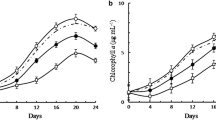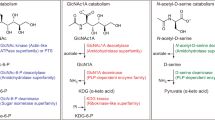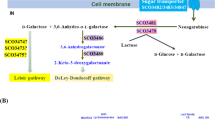Abstract
The myxobacterium, Corallococcus (Myxococcus) coralloides strain Cc c127, could not utilize mono- and disaccharides, but maltotriose and the polysaccharides starch, amylose, amylopectin, and pullulan stimulated growth. Radioactive CO2 was set free from 14C-labeled starch. When starch was degraded, small amounts of maltose and glucose accumulated in the culture supernatant. Maltotriose, however, appeared only temporarily. Outside the cells, the trisaccharide could not be split into glucose and maltose. Pullulan was hydrolyzed exclusively into a trisaccharide which during growth was immediately consumed. Hexokinase, glucose-6-phosphate dehydrogenase, 6-phosphogluconate dehydrogenase and phosphoglucomutase could readily be demonstrated in cell extracts, but fructose-1,6-diphosphate aldolase was present with low activity only. The data suggest that intracellular glucose is metabolized mainly via the pentose phosphate pathway.
Similar content being viewed by others
References
Adachi S (1965) Thin layer chromatography of carbohydrates in the presence of bisulfite. J Chromatogr 17:295–299
Beebe JM (1943) Studies on the myxobacteria. 3. The utilization of carbohydrates. Iowa State Coll J Sci 17:227–240
Bender H, Lehmann J, Wallenfels K (1959) Pullulan, ein extracelluläres Glucan von Pullularia pullulans. Biochim Biophys Acta 36:309–316
Bergmeyer HU, Gawehn K (ed) (1974) Methoden der enzymatischen Analyse. Verlag Chemie, Weinheim
Bretscher AP, Kaiser D (1978) Nutrition of Myxococcus xanthus, a fruiting myxobacterium. J Bacteriol 133:763–768
Dworkin M (1962) Nutritional requirements for vegetative growth of Myxococcus xanthus. J Bacteriol 84:250–257
Gerth K, Reichenbach H (1978) Induction of myxospore formation in Stigmatella aurantiaca (Myxobacterales). Arch Microbiol 117:173–182
Hemphill HE, Zahler SA (1968) Nutrition-of Myxococcus xanthus FBa and some of its auxotrophic mutants. J Bacteriol 195:1011–1017
Irschik H, Jansen R, Höfle G, Gerth K, Reichenbach H (1985) The corallopyronins, new inhibitors of bacterial RNA synthesis from myxobacteria. J Antibiotics 38:145–152
Kunze B, Kemmer T, Höfle G, Reichenbach H (1984) Stigmatellin, a new antibiotic from Stigmatella aurantiaca (Myxobacterales) I. Production, physico-chemical and biological properties. J Antibiotics 37:454–461
Lee EYC, Whelan WJ (1971) Glycogen and starch debranching enzymes. In: Boyer PD (ed) The enzymes, vol 5. Academic Press, New York, pp 191–201
McCurdy HD (1969) Studies on the taxonomy of the Myxobacterales. I. Record of Canadian isolates and survey of methods. Can J Microbiol 15:1453–1461
McDonald JC, Peterson JE (1962) Liquid cultures of two members of the higher fruiting myxobacteria. Mycologia 54:368–373
McGee J, Doudoroff M (1954) A new phosphorylated intermediate in glucose oxidation. J Biol Chem 210:617–626
Morgan FJ, Adams KR, Priest FG (1979) A cultural method for the detection of pullulan-degrading enzymes in bacteria and its applications to the genus Bacillus. J Appl Bacteriol 46:291–294
Norén B (1955) Studies on myxobacteria. III. Organic factors in nutrition. Bot Notiser 108:81–134
Reichenbach H (1984) Myxobacteria: a most peculiar group of social prokaryotes. In: Rosenberg E (ed) Myxobacteria. Development and cell interactions. Springer, Berlin Heidelberg New York, pp 1–50
Reichenbach H, Dworkin M (1969) Studies on Stigmatella aurantiaca (Myxobacterales). J Gen Microbiol 58:3–14
Reichenbach H, Dworkin M (1981) The order Myxobacterales. In: Starr P, Stolp H, Trüper HG, Balows A, Schlegel HG (eds) The prokaryotes. Springer, Berlin Heidelberg New York, pp 328–355
Schwartz M, Hofnung M (1967) La maltodextrine phosphorylase d'Escherichia coli. Eur J Biochem 2:132–145
Solntseva LI (1940) The biology of the myxobacteria. I. Myxococci. Mikrobiologiya 9:217–231 [in Russ]
Solntseva LI (1941) The biology of the myxobacteria. II. The genera Melittangium and Chondromyces. Mikrobiologiya 10:505–512 [in Russ]
Stahl E (1964) Dünnschicht-Chromatographie. In: Rauen HM (ed) Biochemisches Taschenbuch, 2nd edn. Springer, Berlin Heidelberg New York, pp 899–905
Watson BF, Dworkin M (1968) Comparative intermediary metabolism of vegetative cells and microcysts of Myxococcus xanthus. J Bacteriol 96:1465–1473
Author information
Authors and Affiliations
Additional information
Prof. Dr. Gerhard Drews gratefully dedicated to his 60th birthday
Rights and permissions
About this article
Cite this article
Irschik, H., Reichenbach, H. An unusual pattern of carbohydrate utilization in Corallococcus (Myxococcus) coralloides (Myxobacterales). Arch. Microbiol. 142, 40–44 (1985). https://doi.org/10.1007/BF00409234
Received:
Accepted:
Issue Date:
DOI: https://doi.org/10.1007/BF00409234




